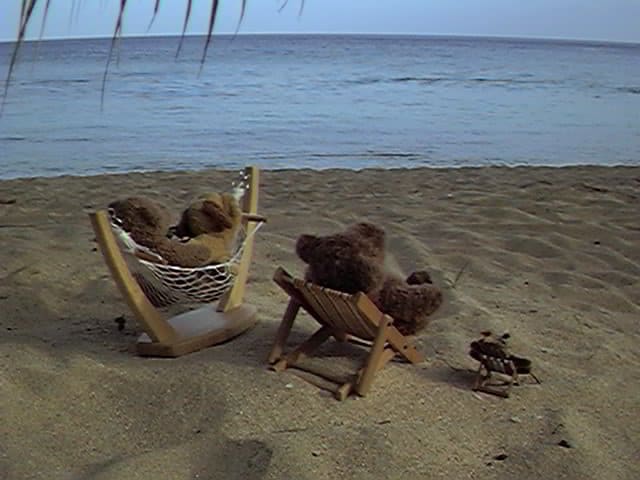What I Learned From My Years Of Being An Arctophile
In case you’ve not heard of the word “arctophile” before, and the image at the top of this article doesn’t give you a big enough clue, it’s a fancy term for somebody who loves (and collects) teddy bears (and, more broadly, soft toys).
For me, it started innocently enough – as most addictions do, I suppose.
I started buying the occasional teddy bear for my first wife, even before we were married.
They were usually nothing special, objectively speaking, and they certainly weren’t expensive, because I wasn’t earning a lot back in those days.
Some were for her birthday or for Christmas, and others were “just because” presents – things I saw I thought she’d like.
After five years of marriage, which is when we moved to a different town because of work, we had a small collection of bears, but I can’t remember how many.
However, shortly after that, we became more than a couple who bought the occasional teddy and other soft toys – we became serious collectors.
Looking back, I honestly cannot remember how it happened – or how I got sucked into it too.
I had continued buying them for my wife, as gifts, so nothing had changed there.
But at some stage, we found a teddy bear shop in the neighbouring town, and we were intrigued and went in.
And, needless to say, we left with one or two – but not the cheapish type we’d bought previously, but expensive, collectible ones.
From then on, our collection grew rapidly – the photo at the top of this article was taken once we reached 200 – we called it the Bicenteddial photo.
We visited the teddy bear shop multiple times a month, having become friends with the couple who owned it, and through them, we joined a teddy bear club that met once a month in a town about 45 miles away from home.
The fact we were willing to travel that far to meet with other teddy bear collectors says enough, I think, but we didn’t stop there.
We planned days out specifically because of the teddy bear shops that were available in that area. For example, we once visited a shop 60 miles away for no other reason than the fact the owner had just bought what was, at the time, the most expensive teddy bear ever to have been bought at auction. (He paid £12,000 for it!)
We went to conventions. (I even performed an after-dinner spot at one, doing magic tricks, including sawing a priceless, unique three-foot tall bear in half, which worried the owner, and convention organizer, more than a bit.)
We started taking some of our teddies on holiday with us – here are a few on the beach in Grenada:

Yes, we’d even bought them a hammock and deck chairs and took them with us in our luggage!
We photographed every single one and completed a bio sheet (e.g. name, adoption date, make, description, cost).
We wrote books about one of our bear’s travel experiences – because there was one small teddy, called Taschy, that travelled in my pocket wherever I went on vacation.
We celebrated their birthdays – not with cards or presents, we weren’t that crazy.
We placed ads in our local newspaper, looking for people who had old teddy bears in good condition who were willing to sell them.
We went to a workshop where I made my own teddy bear, from scratch. (It was the first and only time I’ve used a sewing machine.) This is Josh, even though he’s going a bit bald in places after all these years:

We were, in fact, pretty crazy.
And we found that was not unusual.
For example:
- There were people in our teddy bear club who were using teddies to help them with diagnosed mental health problems. (At least we hadn’t been diagnosed – yet.)
- There was a lady who took great solace in her rapidly increasing collection of bears (which she could hardly afford) after the sudden and early death of her husband. She also started writing poems about bears, which she said she created in a form of automatic-writing – the poems just “came to her”. Once her mental health stabilized, her interest in bear became less obsessive, which was interesting.
- There were people to took their bears a lot more seriously than we did, if you can imagine that, based on what I’ve already said.
- There was one guy who collected bears by a specific manufacturer (one of the first companies to make teddy bears), but here’s the weird thing – he bought all of their collectible, limited edition bears – even though he didn’t like some of them, because if he didn’t, his collection wouldn’t be complete.
- We met a lady who bought three of each collectible bear – one to admire (and maybe play with), one as a back-up (whatever that meant), and one as an investment.
At the height of our collection, in 2004, we had over 600 bears and other assorted soft toys in our house – they were everywhere!
And it was obvious, not only to any visitors but to us, that things had got completely out of hand.
Shortly after that, I divorced my first wife and we sent most of the bears to auction. I still have a handful of them, including the one I made that I mentioned above, in boxes I’ve not yet unpacked after being in the USA for over 14 years, and I suspect my ex-wife has somewhat more than I do.
So, what did I learn from all of this?
- I think it’s scary how something that starts off as innocent fun can become something more serious.
And if you doubt how serious it became, for some people, you should have seen them fighting over teddy bears at a convention, literally stealing them out of somebody else’s hand because they wanted them so badly.
- Worse than that, collecting can take over your life and become a real obsession, and there wasn’t really a point when you could say, OK, I’ve crossed the line there.
And when I look at some of the members of the bear club I belonged to, as I mentioned above, there were those who did have serious mental health issues. I just don’t know which came first – the mental problem or the collecting, but it was worrying to me at the time that I might become like them one day.
- Collecting things can cost money – a lot of money. I really hate to think how much we spent on our collection over the course of 20 years or so.
And I get that collecting needn’t always be expensive – to begin with. But I had a colleague and friend where he and his wife started collecting things they liked, picking them up at flea markets and car boot sales for very little money, until those items became popular and the prices skyrocketed beyond their budget, to the point where they could no longer afford to buy those items. They then started collecting something else, and the same thing happened. And then it happened again with a third type of item. And then they gave up collecting anything.
- Depending on what you collect, storage space can be a real issue. Some of our teddies were tiny, while others were two or three tall, so trying to find somewhere to put 600 of them in an average-sized home was tricky – which is why they were everywhere.
Some people keep their collections in drawers or display cabinets, depending on what they collect, but to us, there was no point collecting teddy bears (or anything) if you couldn’t see them.
One man we knew, the one bought all of the collectibles by a certain company regardless of whether he liked them or not, had so little space that he had to keep them all in their original boxes, which meant he never even got to see his bears, which seems sad and pointless. (On the plus side, being in their boxes increased their value, not that his plan was to sell them as far as I know.)
- When it came time to send them to auction, they sold for far less than we had paid for them. I’m not talking about the small, mass-produced bears here, but the ones that were collectible, limited edition ones. We honestly thought that most of those would at least fetch what we paid for them, but no, not even close.
So if you’re going to collect something, make sure you understand why you’re doing it.
And if you think it’s an investment, you had better make sure there is (or will be) a good market for them later on, should you decide to sell them.
For us, we had never intended to part with them (not that we had made any long-term plans for what to do with them either), and it was only the divorce that forced the issue.
- When your collection grows, to the point where you cannot ignore the fact that you have a lot of whatever it is you’re collecting, you need to be prepared for other people to think you’re weird or crazy.
Those who collect the same type of items, and collectors in general, will probably be OK with it (to a point), but people who are not collectors themselves may distance themselves from you a bit.
We had somebody come to the house once, for a small dinner party, who asked us which 10% of our bears were gay, and which ones were vegetarian – because she was translating human demographics into our bear population. I’m not sure how serious she was, or whether she was passive-aggressively trying to point out how crazy we were, but it was indicative of the sort of reaction you may get.
Conclusion
My story is about collecting teddy bears, but it could, of course, apply to anything.
The key thing is to try to realize when a fun hobby changes into something that is less about having fun and more about collecting for the sake of collecting. It happened to me, and I’ve seen it happen far worse to other people too.
And remember that other activities can turn into obsessions too – whatever starts out as being something you do for fun can be taken too far.
But ultimately, if collecting (or doing) something brings you pleasure, then go for it.
Additional Resources
These are suggestions for those who wish to delve deeper into any of the above:







